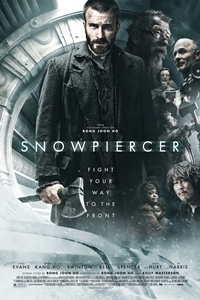 Snowpiercer
Snowpiercer
Starring Chris Evans, John Hurt, Tilda Swinton, Jamie Bell and Octavia Spencer
Directed by Joon-ho Bong
From The Weinstein Company
Rated R
126 minutes
All aboard! Snowpiercer victoriously steams through summer
by Michael Clawson of Terminal Volume
Dust the peanut shells off your shirt, gather your stuff and start heading for the car: With outs still left to play, Joon-ho Bong’s succulent sci-fi masterpiece Snowpiercer just hit a walk-off home run to end the summer.
I’m not one to romanticize the summer’s popcorny action blockbusters. It’s a phenomenon that has grown to a worrisome size and brand of exclusivity — entrance is only granted by way of $200 million or more, and its only members are superheroes and transforming robots. But every now and again a movie like Snowpiercer comes along in the heat of the summer to obliterate our movie expectations.
This is a wholly unique and fascinating movie, one that further proves the most daring and groundbreaking movies have been from the science fiction genre, which is rich with ideas and spectacular invention. The movie takes place aboard a massive train that is plowing around the frozen globe, the result of a botched cloud-seeding experiment 17 years ago to reverse global warming. The outside world, extinct of all life, is wintery white and equally frigid, yet on the train there is heat, food, shelter and safety, but to varying degrees of concentration.
The humanity that survived the winter apocalypse have been assigned social classes aboard the train, which is so long that engine and caboose are presumably separated by area codes. Wealthy one-percenters ride near the front in lavish comfort, while the poor and undesirable ride in the rear, a gulag of cold steel and unbearable conditions. This is where we meet Curtis (Chris Evans), who has grown weary of the Marxist dystopia the rear of the train has provided him. It’s cramped, there are mandatory public countings, brutal beatings, children are kidnapped, and the food, protein bricks made of what looks like black cherry Jell-O, isn’t quite Soylent Green, but it’s close.
Curtis and the other supporters of wise village elder Gilliam (John Hurt) stage a massive revolt that requires them to time the opening and closing of train doors with the brute force of a hastily constructed battering ram made of metal drums. Once they’re through the first couple cars, they start picking up momentum as they race from their third-world prison up through the social classes.
The film has some marvelous performances, including a showstopper by Tilda Swinton as a kooky government leader, but let’s make no mistake about this: the star here is the train, which is so expertly designed and utilized within the plot that it’s a character unto itself. First, the look and feel of the train is just perfect. It’s wide enough to contain action and storytelling without feeling cramped, but tight enough to create a sense of claustrophobia when it’s needed. And at some point these train cars existed on a real set somewhere, because when the camera looks through open doors you can see distant cars undulating in the distant. It’s a hypnotic special effect. Bong also does a clever trick: he doesn’t show us any cars that Curtis hasn't yet visited. This allows us to explore the train as Curtis does, from the industrial refinery cars through to the greenhouse and aquarium cars and later in cars devoted to steam saunas and dance clubs. Watch how even the color temperature changes from the blues and greys of the rear of the train to the warm and organic browns and yellows of the paneled sleeping cars.
The train’s prominent role in the film also gives it some stand-out performances, including when two men have to wait for a sharp curve for the train to bend enough so they can see each other for a firefight. In another scene, a massive brawl is halted so the murderous combatants can count down to an eventual “Happy New Year!” They know it’s a new year because the train, which takes a full year to circumnavigate the globe, crosses a specific bridge. After some cheering and a little song they all return to killing.
Most importantly, though, the train has relevance within the plot. Bong and fellow screenwriter Kelly Masterson (Before the Devil Knows You’re Dead) have created a substantive mythology from the speeding locomotive’s existence. Curtis’ journey from one end to the other isn’t just a road movie, it’s metaphor, allegory, spiritual parable … it’s whatever you want it to be: young and old, life and death, rich and poor, head and tail. Interpretations of the train’s implications are going to be like the locomotive’s meandering journey around the world — all over the map.
This isn’t quite high art, though it’s awful close and it does have its fair share of brawls, shootouts, swordfights, riots, plenty of violence and scenes that reveal the true, and terrifying, nature of the train and its inhabitants. John Hurt’s character wears an umbrella handle where his hand once was; that makes for a doozer of a story late in the movie. There’s a sequence in a school car that is nuttier than it has any right to be, yet it also provides some important exposition about the train’s engine and the prophet-like man who supposedly keeps it running. In yet another scene, immediately after an action bonanza, the main characters stop at a sushi restaurant and have a bite to eat. The film has it’s own pace and tempo, but the movements work surprisingly well.
Go see this movie. You might have missed Transformers 4 last week; keep missing it and instead put your money into a movie that you haven’t yet seen, or will likely see again.









